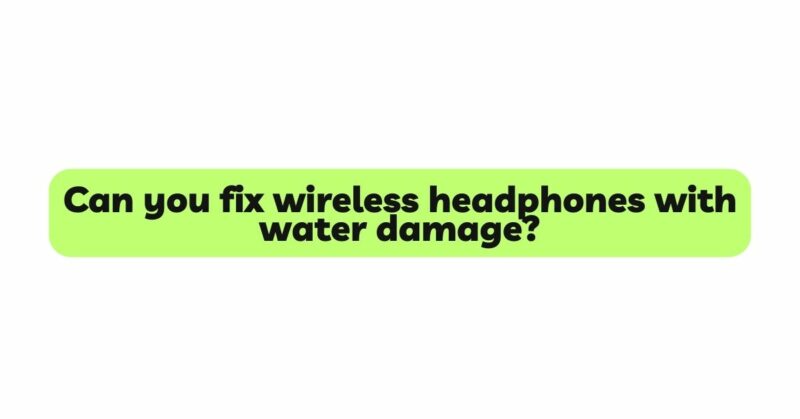In today’s fast-paced world, wireless headphones have become an indispensable accessory for many individuals seeking a seamless audio experience. Whether you use them for commuting, exercising, or simply enjoying your favorite tunes, these compact gadgets have revolutionized the way we listen to music and interact with our devices. However, accidents happen, and one of the most common mishaps is water damage. When your beloved wireless headphones encounter moisture, it can be a distressing situation. The question arises: Can you fix wireless headphones with water damage? In this article, we will delve into the intricacies of water damage and explore possible solutions to bring your headphones back to life.
Understanding Water Damage and Its Effects:
Wireless headphones are delicate electronic devices with intricate circuitry and sensitive components. When exposed to water or any other liquid, several factors determine the extent of the damage, such as the type of liquid, the duration of exposure, and the specific headphone model. In general, water damage can lead to the following issues:
- Electrical Short Circuits: When water breaches the protective barriers of your headphones and comes into contact with electrical circuits, it can cause short circuits. This can lead to malfunctioning of various components, rendering the headphones inoperable.
- Corrosion: Moisture encourages the formation of rust and corrosion on metal components, which can cause irreversible damage over time.
- Speaker and Microphone Issues: Water damage can affect the speakers and microphones, leading to distorted audio output or even complete sound loss.
- Battery Damage: If water infiltrates the battery compartment, it can damage the battery and potentially cause dangerous situations, such as leaks or explosions.
- Software Malfunctions: Some wireless headphones have built-in software to control various features. Water damage may cause glitches in this software, leading to functionality problems.
What to Do Immediately After Water Exposure:
- Turn Off the Headphones: If your wireless headphones get wet, the first and most crucial step is to turn them off immediately. Disconnect them from any power source and avoid attempting to use them until you are certain they are dry.
- Remove External Moisture: Gently wipe the headphones with a soft, absorbent cloth to remove any visible moisture. Avoid using excessive force or rubbing, as it may push water further into the device.
- Shake Off Excess Water: If water has seeped into crevices or ports, gently shake the headphones to encourage water drainage. Be cautious not to shake them too vigorously, as this could cause additional damage.
- Open the Charging Port Cover: If your headphones have a charging port cover, open it to aid in the drying process. This allows better airflow and helps moisture escape.
Drying Methods:
- Air Drying: Air drying is one of the safest methods to attempt at home. Place your headphones in a dry and warm area with good air circulation. You can keep them on a soft, absorbent cloth or paper towel. Avoid direct sunlight or using a hairdryer, as excessive heat can damage the internal components.
- Silica Gel Packs: Silica gel packs, often found in shoeboxes or certain product packaging, are excellent moisture absorbers. Place your headphones and a few gel packs in an airtight container or resealable bag and let them sit for a day or two. The silica gel will help draw out the moisture from the headphones.
- Rice: While rice has been a popular remedy for water-damaged devices, it is not the most effective. It can even leave tiny rice particles inside the headphone ports, causing further issues. However, if it’s your only option, use uncooked rice and place your headphones in a bag filled with rice for a day or two.
- Desiccant Packets: Similar to silica gel packs, desiccant packets can be effective in absorbing moisture. You can find them at hardware stores or online. Place your headphones and the desiccant packets in a sealed container and let them sit for a day or two.
Professional Repair Services:
If the above methods fail to restore your headphones, it’s time to consider professional repair services. Seek out authorized service centers or skilled technicians with experience in handling water-damaged electronics. They can disassemble the headphones, assess the extent of the damage, and perform precise repairs, replacing damaged components if necessary.
Preventing Water Damage:
Prevention is always better than a cure. Here are some tips to safeguard your wireless headphones from water damage:
- Water-Resistant Headphones: Consider investing in water-resistant or waterproof headphones if you frequently use them in environments where moisture is a concern.
- Protective Cases: Use a sturdy and waterproof carrying case when transporting your headphones, especially during outdoor activities.
- Be Mindful During Workouts: If you use headphones while exercising, choose sweat-resistant models and be cautious with excessive sweat or moisture.
- Weather Awareness: Be mindful of the weather conditions when using your headphones outdoors. Keep them protected during rain or high humidity.
Conclusion:
While water damage to wireless headphones can be distressing, there are potential remedies to restore them to functionality. Acting swiftly and employing the right drying methods can increase the chances of successful recovery. However, prevention remains the best approach to safeguard your headphones from water damage. By following these guidelines, you can ensure a longer lifespan for your audio gear and continue to enjoy a seamless and immersive audio experience.


